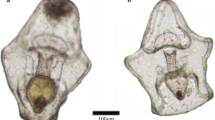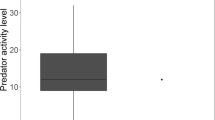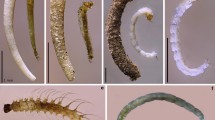Summary
In Crystal Lake, British Columbia, small fry (≤15 mm SL) of the threespine stickleback (Gasterosteus aculeatus) are concentrated in vegetation while larger fry are not. Because fry in all size classes feed primarily on zooplankton, even when in vegetation, we hypothesized that size-limited predation was responsible for the observed shift in habitat use with size. The major predators on fry in Crystal Lake are adult threespine stickleback, the water scorpion, Ranatra sp. (Hemiptera: Nepidae), backswimmers, Notonecta spp. (Hemiptera: Notonectidae), and dragonfly naiads of the genus Aeshna (Odonata: Aeschnidae). On the basis of distribution and hunting behavior we excluded the insects Ranatra sp., and Notonecta sp. as causal agents for this shift in resource by fry in water >0.25 m deep. Ranatra was found almost exclusively near the shoreline in water <0.25 m deep, and both insects hunted primarily as ambush predators within vegetation. Such predators seemed more likely to drive vulnerable fry from vegetation than to restrict them to it. In contrast, Aeshna naiads and adult stickleback frequently hunted outside of vegetation. In prey preference experiments the naiads did not show the decline in predation efficiency on fry >15 mm SL that would be expected if size-limited predation by this insect was responsible for the observed shift in resource use by fry. Adult stickleback only fed on fry <15 mm SL, and in an experimental situation, consumed fry at a rate 10 times greater than that exhibited by any of the insects. Predation experiments demonstrated that small fry (11–15 mm) spent more time in vegetation in the presence of adult conspecifics than they did in control pools, as would be expected if size-limited cannibalism caused small, vulnerable fry to be restricted to vegetation. Fry >15 mm SL were found outside of vegetation more often than in control treatments. The probable cause of this result is that adults become aggressive toward fry at this size, and often could be seen chasing large fry from vegetation during the experiments. Dragonfly naiads (Aeshna spp.) spent most of their time in vegetation in the experimental pools. Both size classes of fry spent less time in vegetation in the presence of dragonfly naiads than they did in control treatments, an apparent reflection of their similar vulnerabilities to these naiads. The presence of vegetation in pools reduced predation rates by adult stickleback on small fry. Because the experiments presented here indicate that fry are capable of rapidly assessing predation risk and of altering their behavior adaptively, we conclude that small fry occupy vegetation as a refuge from cannibalism. Once fry have reached the size-threshold at which they are no longer vulnerable to adult conspecifics they are able to forage farther from vegetation thereby reducing risk of predation by insects in vegetation and possibly acquiring more abundant food resources.
Similar content being viewed by others

References
Brown JA (1985) The adaptive significance of behavioural ontogeny in some centrarchid fishes, Env Biol Fish 13:25–34
Caldwell JP, Thorp JH, Jervey TO (1980) Predator-prey relationships among larval dragonflies, salamanders, and frogs. Oecologia (Berlin) 46:285–289
Calef GW (1973) Natural mortality of tadpoles in a population of Rana aurora. Ecology 54:741–758
Caraco T, Martindale S, Pulliam HR (1980) Avian flocking in the presence of a predator. Nature 285:400–401
Connell JH (1970) A predator-prey system in the marine intertidal region. I. Balanus glandula and several predatory species of Thais. Ecol Monogr 40:49–78
Connel JH (1970) On the role of natural enemies in preventing competitive exclusion in some marine animals and in rain forests. In: Boer PJ den, Gradwell GR (eds) Proceedings of the Advance Study Institute on Dynamics of Numbers Populations (Oosterbeck 1970). Centre for Agricultural Publishing and Documentation, Wageningen, pp 298–312
Connell JH (1975) Some mechanisms producing structure in natural communities. In: Cody MI, Diamond JM (eds) Ecology and evolution of communities. Harvard University Press, Cambridge, pp 460–490
Cook WL, Streans FA (1984) Fish predation on Notonecta (Hemiptera): relationship between prey risk and habitat utilization. Oecology (Berlin) 64:177–183
Crowder LB, Cooper WE (1982) Habitat structural complexity and the interaction between bluegills and their prey. Ecology 63:1802–1813
Crump ML (1984) Ontogenetic changes in vulnerability to predation in tadpoles of Hyla pseudopuma. Herpetologica 40:265–271
Ebeling AW, Laur DR (1985) The influence of plant cover on surfperch abundance at an offshore temperate reef. Envir Biol Fish 12:169–180
FitzGerald GJ (1983) The reproductive ecology and behaviour of three sympatric sticklebacks (Gasterosteidae) in a salt marsh. Biol Behav 8:67–79
Fox LR (1975) Factors influencing cannibalism, a mechanism of population limitation in the predator Notonecta hoffmanni. Ecology 56:933–941
Fraser DF, Cerri RD (1982) Experimental evaluation of predatorprey relationships in a patchy environment consequences for habitat use patterns in minnows. Ecology 63:307–313
Gilbert JJ (1967) Asplanchna and postero-lateral spine production in Brachionus calyciflorus. Arch Hydrobiol 64, 1–62
Gilbert JJ, Stemberger RS (1984) Asplanachna-induced polymorphism in the rotifer Keratella slacki. Limnol Oceanog 29:1309–1316
Glass NR (1971) Computer analysis of predation energetics in the largemouth bass. In: Patten BC (ed) Systems analysis and simulation in ecology. Academic Press, New York, pp 326–363
Hall DJ, Werner EE (1977) Seasonal distribution and the abundance of fishes in the littoral zone of a Michigan lake. Trans Am Fish Soc 106:545–555
Harper JL (1977) Population biology of plants. Academic Press, London
Hausfater G, Hrdy SB (1984) Infanticide. Aldine, Hawthorn, New York
Holbrook SJ, Schmitt RJ (1984) Experimental analyses of patch selection by foraging surfperch, (Embiotoca jacksoni Agazzi). J Exp Mar Biol Ecol 79:39–64
Jackson PBN (1961) The impact of predation especially by the tiger fish (Hydrocynus vittatus Cast.) on African freshwater fishes. Proc Zool Soc London 136:603–622
Kadel K (1975) Freilandstudien zur Uberlevenstrate von Kreuzdrotenlarven (Bufo calamita Laur.). Rev Suisse Zool 83:237–244
Keast A, Harker J, Turnbull D (1978) Nearshore fish habitat utilization and species associations in Lake Opinicon (Ontario, Canada). Env Biol Fish 3:173–184
Kynard BE (1978) Breeding behavior of a lacustrine population of threespine sticklebacks (Gasterosteus aculeatus L.). Behaviour 67:178–207
Laughlin DR, Werner EE (1980) Resource partitioning in two coexisting sunfish: pumpkinseed (Lepomis gibbosus) and northern longear sunfish (Lepomis megalotis peltastes). Can J Fish Aquat Sci 37:1411–1420
Lubchenco J (1983) Littorina and Fucus: effect of herbivores, substratum heterogeneity, and plant escapes during succession. Ecology 64:1116–1123
Milinski M, Heller R (1978) Influence of a predator on the optimal foraging behaviour of sticklebacks (Gasterosteus aculeatus). Nature 275:642–644
Mittlebach GG (1981) Foraging efficiency and body size: a study of optimal diet and habitat use by bluegills. Ecology 62:1370–1386
Mittlebach GG (1984) Predation and resource partitioning in two sunfishes (Centrarchidae). Ecology 65:499–513
Moodie GEE (1972) Morphology, life history and ecology of an unusual stickleback (Gasterosteus aculeatus) in the Queen Charlotte Islands, Canada. Can J Zool 50:721–732
Paine RT (1966) Natural history, limiting factors and energetics of the opisthobranch Navanax inermis. Ecology 46:603–619
Paine RT (1976) Size-limited predation: an observational and experimental approach with the Mytilus-Pisaster interaction. Ecology 57:858–873
Peterkin GF, Tubbs CR (1965) Woodland regeneration in the New Forest, Hamsphire, since 1650. J Appl Ecol 2:159–170
Polis GA (1981) The evolution and dynamics of intraspecific predation. Ann Rev Ecol Syst 12:225–251
Polis GA (1984) Intraspecific predation and “infant killing” among invertebrates. In: Hausfater G, Hrdy SB (eds) Infanticide. Aldine, Hawthorn, New York
Popova O (1967) The ‘predator prey’ relationship among fishes. In: S. Gerking (ed) The biological basis of, freshwater fish production. Blackwell, Oxford, pp 359–376
Power ME, Matthews WJ, Stewart AJ (1985) Grazing minnows, piscivorous bass and stream algae: dynamics of a strong interaction. Ecology 66:1448–1456
Reimchen TE (1980) Spine deficiency and polymorpism in a population of Gasterosteus aculeatus: an adaptation to predators? Can J Zool 58:1232–1244
Savino JF, Stein RA (1982) Predator-prey interaction between largemouth bass and bluegills as influenced by simulated, submersed vegetation. Trans Am Fish Soc 111:255–266
Schlosser IJ (1987) The role of predation in age- and size-related habitat use by stream fishes. Ecology 68:651–659
Schmitt RJ, Holbrook SJ (1985) Patch selection by juvenile black surfperch (Embiotocidae) under variable risk: interactive influence of food quality and structural complexity. J Exp Mar Biol Ecol 85:269–285
Schultz JC (1981) Adaptive changes in antipredator behavior of a grasshopper during development. Evolution 35:175–179
Semler DE (1971) Some aspects of adaptation in a polymorphism for breeding colours in the threespine stickleback (Gasterosteus aculeatus) J Zool Soc Lond 165:291–302
Sih A (1980) Optimal behavior: can foragers balance two conflicting demands? Science 210:1041–1043
Sih A (1982) Foraging strategies and the avoidance of predation by an aquatic insect Notonecta hoffmani. Ecology 63:786–796
Sokal RR, Rohlf FJ (1981) Biometry. Freeman, San Francisco
Stein RA (1977) Selective predation, optimal foraging and the predator-prey interaction between fish and crayfish Ecology 58:1237–1253
Stein RA, Magnuson JJ (1976) Behavioral response of crayfish to a fish predator. Ecology 58:571–581
Travis J, Keen WH, Juilianna J (1985) The role of relative body size in a predator-prey relationship between dragonfly naiads and larval anurans. Oikos 45:59–65
Werner EE (1979) Niche partitioning by food size in fish communities. In: Stroud, RH, Clepper H (eds) Predator-prey systems in fisheries management. Sport Fishing Institute, Washington DC, pp 311–322
Werner EE (1984) The mechanisms of species interactions and community organization in fish. In: Strong DR, Simberloff D, Abele LG, Thistle AB (eds) Ecological communities: conceptual issues and the evidence. Princeton University Press, Princeton, NJ, pp 360–382
Werner EE, Hall DJ (1979) Foraging efficiency and habitat switching in competing sunfishes. Ecology 60:256–264
Werner EE, Gilliam JF (1984) The ontogenetic niche and speices interactions in size-structured populations. Ann Rev Ecol Syst 15:393–425
Werne EE, Hall DJ, Laughlin DR, Wagner DJ, Wilsmann LA, Funk FC (1977) Habitat partitioning in a freshwater fish community. J Fish Res Board Can 34:360–370
Werner EE, Gilliam JF, Hall DJ, Mittlebach GG (1983) An experimental test of the effects of predation risk on habitat use in fish. Ecology 64:1540–1548
Werner EE, Mittlebach GG, Hall DJ, Gilliam JF (1983) Experimental tests of optimal habitat use in fish: the role of relative habitat profitability. Ecology 64:1525–1539
Whorisky FG, FitzGerald GJ (1985) Sex, cannibalism and sticklebacks. Behav Ecol Sociobiol 18:15–18
Wootton FJ (1971) A note on the nest-raiding behaviour of male sticklebacks. Can J Zool 49:960–962
Wootton FJ (1976) The biology of sticklebacks. Academic Press, London
Zar JH (1984) Biostatistical analysis. Prentice-Hall, Englewood Cliffs, NJ
Zaret TM (1980) Predation and freshwater communities. Yale University Press. New Haven, Connecticut
Author information
Authors and Affiliations
Rights and permissions
About this article
Cite this article
Foster, S.A., Garcia, V.B. & Town, M.Y. Cannibalism as the cause of an ontogenetic shift in habitat use by fry of the threespine stickleback. Oecologia 74, 577–585 (1988). https://doi.org/10.1007/BF00380056
Received:
Issue Date:
DOI: https://doi.org/10.1007/BF00380056



